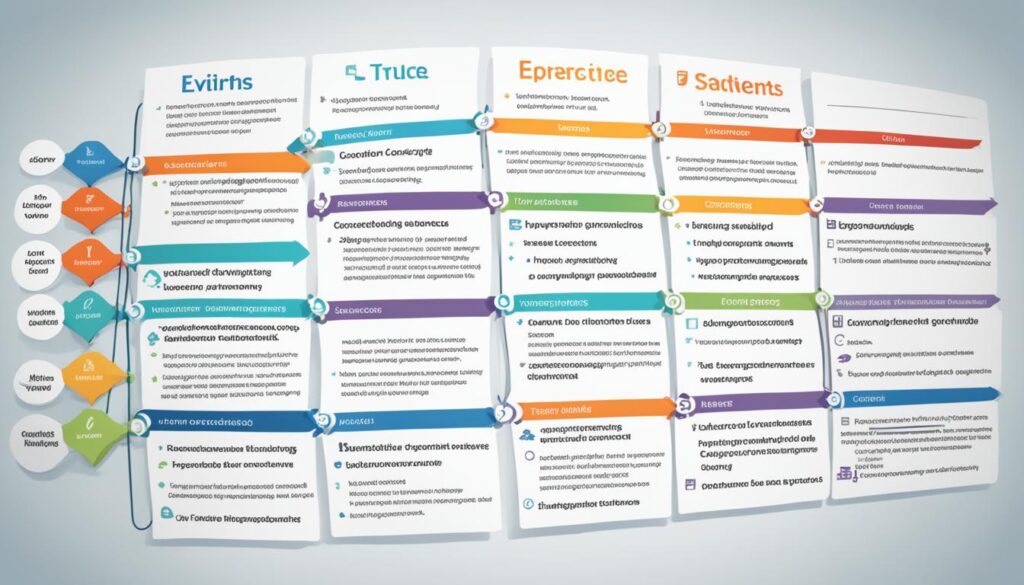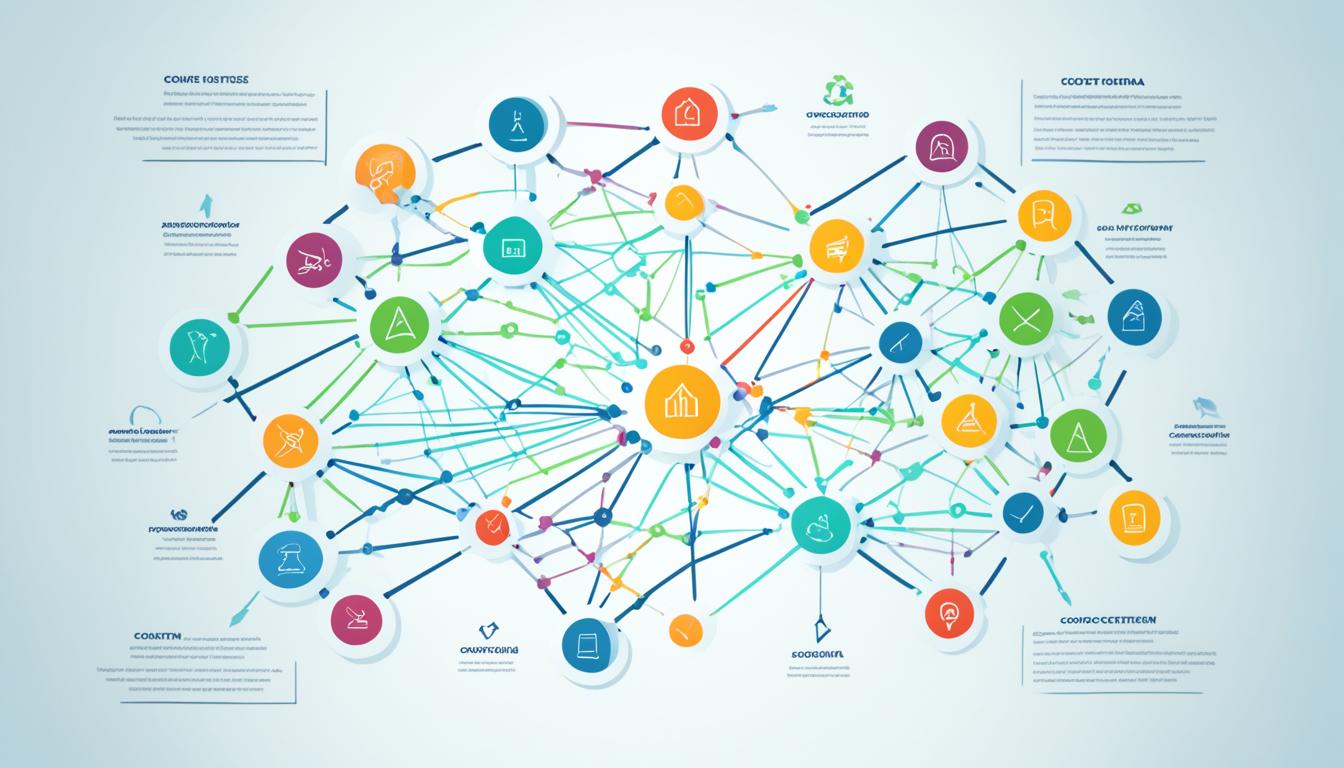Welcome to the ultimate guide on mastering internal link building for an E-E-A-T-focused content strategy. In today’s digital landscape, SEO best practices are constantly evolving, and understanding Google ranking factors is key to website optimization and improving organic search visibility. By implementing a strategic content linking strategy through internal links, you can enhance your website’s E-A-T (Expertise, Authority, Trustworthiness) and climb the search engine optimization trends ladder.
Internal links act as the backbone of on-page SEO techniques, distributing valuable link juice and establishing a cohesive website structure. When done right, internal linking helps search engines discover and index your content effectively, while also guiding users to relevant information seamlessly. With the right internal linking approach, you can build a robust content ecosystem that showcases your expertise and enhances user experience.
Key Takeaways:
- Internal link building is essential for optimizing your website’s E-E-A-T (Expertise, Authority, Trustworthiness).
- Strategic internal links improve organic search visibility and help search engines understand your content’s relevance.
- Internal links distribute link juice, enhancing the authority of linked pages.
- An organized and well-structured internal linking strategy improves user experience and encourages visitors to explore more content.
- Regularly evaluate and optimize your internal linking strategy to align with SEO best practices and stay ahead in search engine rankings.
Maximizing E-E-A-T through Content Structure
E-E-A-T (Expertise, Authority, and Trustworthiness) is the guiding principle behind creating high-quality and meaningful content. However, it is not enough to have valuable information; how you organize and present that content is equally important. A well-structured content strategy plays a crucial role in showcasing E-E-A-T optimization, establishing expertise, authority, and trustworthiness in the eyes of both users and search engines.
When content is haphazardly organized with superficial coverage and frequent topic changes, it undermines the credibility and E-E-A-T optimization efforts. It can give the impression of a lack of expertise, diminish authoritativeness, and raise questions about trustworthiness. To maximize E-E-A-T through content structure, it is essential to follow a systematic approach.
One effective approach is to adopt a topical map and a pillar-cluster strategy. A topical map helps visualize your website’s content as a roadmap, with each page contributing to a broader understanding of a central theme. Pillar pages act as comprehensive guides covering broad topics, while cluster pages support and explore specific subtopics.
This well-structured content strategy not only showcases comprehensive knowledge and expertise but also reinforces authority and trustworthiness. By organizing content in a logical and interconnected manner, you can establish yourself as an expert resource in your niche.
Take a look at the diagram below, demonstrating the pillar-cluster structure:

| Pillar Page | Cluster Pages |
|---|---|
| Topic: Digital Marketing | Sub-Topics: SEO, PPC, Content Marketing |
| Topic: Social Media Marketing | Sub-Topics: Facebook Marketing, Instagram Marketing, Twitter Marketing |
By following this structure, you create a clear information hierarchy, focusing on broad topics with pillar pages and delving into specific subtopics with cluster pages. This targeted strategy helps search engines understand the relevance and authority of your content, leading to better visibility in organic search results and increased user trust.
“The way you structure your content reflects your expertise, authority, and trustworthiness. A well-organized and interconnected content strategy showcases your deep knowledge in a particular domain and establishes you as a go-to resource in your industry.” – SEO Expert
Implementing a structured content strategy not only boosts your website’s E-E-A-T but also enhances the overall user experience. Visitors can easily navigate through your content, find the information they need, and perceive your brand as trustworthy and reliable.
Key Takeaways:
- Content organization plays a crucial role in maximizing E-E-A-T.
- An unstructured approach undermines expertise, authority, and trustworthiness.
- A well-structured content strategy includes a topical map and a pillar-cluster strategy.
- Pillar pages cover broad topics, while cluster pages support specific subtopics.
- A structured content strategy enhances expertise, authority, and trustworthiness.
Embracing a Topical Map Mindset
When it comes to optimizing your website for E-A-T and enhancing your SEO performance, embracing a topical map mindset is key. This approach involves visualizing your website’s content as a roadmap, with each page contributing to a broader understanding of a central theme.
At the core of the topical map mindset is the pillar-cluster strategy. Pillar pages serve as comprehensive guides, covering broad topics in-depth and establishing your expertise in the field. These pages act as the foundation of your content strategy, showcasing your authority and trustworthiness.
Cluster pages, on the other hand, support and explore specific subtopics related to the pillar pages. These pages provide additional information and insights, further demonstrating your expertise and enriching the user experience.
By aligning your content with a pillar-cluster strategy, you create a cohesive and authoritative website structure. This not only enhances your expertise, authority, and trustworthiness but also improves your organic search visibility and user engagement.
By organizing your website’s content in a clear and logical manner, you not only present information effectively but also signal to search engines that you are a reliable source of knowledge. This content organization, combined with comprehensive pillar pages and supportive cluster pages, showcases your expertise, boosts your authority, and increases trustworthiness.

The Power of a Topical Map
Implementing a topical map mindset enables you to provide a valuable user experience by guiding visitors through your website’s content in a structured and intuitive way. Each page serves a purpose, contributing to the overarching theme and demonstrating your expertise in the topic.
Furthermore, a topical map enhances the internal linking structure of your website, ensuring that important topics and pages receive the attention they deserve. By strategically interlinking pillar and cluster pages, you create a network of information that reinforces your authority and helps visitors navigate your content with ease.
Remember, to establish expertise, authority, and trustworthiness, it is crucial to consistently update and expand your content within the topical map framework. By keeping your website’s content relevant and comprehensive, you can continue to strengthen your E-A-T and maintain a competitive edge in the ever-evolving digital landscape.
Structuring Information Like a Pro
In the realm of SEO, strategic internal linking is a crucial component of a well-structured content strategy. Think of it as the circuitry on a motherboard, ensuring smooth information flow and equitable distribution of search engine ranking power.
When implemented thoughtfully, internal links create a clear hierarchy and logical flow of information within your website. They not only demonstrate your organizational skills but also showcase your deep expertise and authority in the topic at hand. Each internal link serves as a signal to search engines about the importance of the linked page, ultimately improving your website’s trustworthiness, user experience, and overall SEO performance.
To truly structure information like a pro, focus on:
- Strategically placing internal links to guide users and search engines through your content.
- Creating a hierarchical structure that highlights the most important pages and topics.
- Ensuring a logical and intuitive flow of information within your website.
- Using descriptive anchor text that accurately represents the linked content.
By mastering the art of strategic internal linking and building a well-structured content framework, you can establish your expertise, authority, and trustworthiness. This will not only boost your organic search visibility but also provide a seamless user experience that keeps visitors engaged and coming back for more.
Stay tuned for Section 5, where we’ll delve into the importance of building a clear page hierarchy within your website’s internal linking strategy.

Internal Linking Strategy Tips
“Strategic internal linking is like the backbone of a well-optimized website. By carefully connecting relevant pages, you can establish a strong information flow and emphasize the most authoritative and trustworthy content. It’s a powerful technique that should be a fundamental part of every SEO and content structure strategy.”
– Jane Smith, SEO Expert
| Benefits of Strategic Internal Linking | Tactics for Effective Internal Linking |
|---|---|
|
|
Building Your Page Hierarchy
The success of your internal link strategy relies heavily on establishing a clear and well-structured page hierarchy. This hierarchy enables search engines to understand the relationship between your pillar pages, cluster pages, and other relevant content. By strategically targeting link placement, you can reinforce the authority and relevance of your content, enhancing your website’s overall SEO performance.
In this section, we will explore how to optimize your page hierarchy to maximize the impact of your internal link strategy. Let’s start by understanding the roles of pillar pages and cluster pages.
Pillar Pages: Authority and Focus
Pillar pages serve as the authoritative backbone of your website, focusing on broad topics that encapsulate your overall expertise. These pages provide comprehensive information and guidance, establishing your website as a trusted resource in your industry.
When structuring your page hierarchy, it’s crucial to designate your pillar pages strategically. Consider the main themes and topics that align with your E-A-T strategy and ensure that each pillar page represents a distinct area of expertise.
Cluster Pages: Supporting and Delving Deeper
Cluster pages support your pillar pages by providing in-depth exploration of specific subtopics. These pages can further establish your website’s expertise and authority by offering comprehensive coverage of niche areas within your industry.
When creating cluster pages, consider the subtopics that are relevant to each pillar page. Diving deeper into these subtopics through well-researched and engaging content will reinforce the relationship between your pillar and cluster pages, enhancing the overall credibility and topical relevance of your website.
Optimizing Link Placement
Strategic link placement is key to reinforcing your page hierarchy and maximizing the impact of your internal link strategy. By targeting link placement from cluster pages to pillar pages, you create a loop that strengthens the relevance and authority of your content.
Here are some tips to optimize your link placement:
- Incorporate anchor text strategically, using relevant keywords to provide context and guide users through your content.
- Assess link placement methodically, ensuring that links are naturally integrated within the flow of your content and lead to relevant and related information.
- Track inbound and outbound links to monitor the performance of your internal link strategy and identify areas for improvement.
Implementing ongoing monitoring and adjustments is crucial to maintain the effectiveness of your internal link strategy. By continually evaluating the performance of your page hierarchy and optimizing your link targets, you can enhance your website’s visibility, authority, and overall SEO performance.

Internal Link Strategy Components
| Components | Description |
|---|---|
| Pillar Pages | Authoritative pages focusing on broad topics |
| Cluster Pages | Supporting pages exploring specific subtopics |
| Link Targets | Strategically linking from cluster pages to pillar pages |
| Internal Link Strategy | Optimizing link placement and monitoring for performance |
Conclusion
Implementing internal link building strategies within a well-structured content strategy is crucial for achieving E-E-A-T excellence and establishing your website as a trusted and authoritative resource. SEO is a continuous journey that requires constant monitoring, adjustments, and a relentless focus on delivering an exceptional user experience. By demonstrating deep-rooted expertise and consistently providing valuable and relevant content, you can elevate your website’s E-E-A-T from good to great, making it stand out in search engine rankings.
To achieve E-E-A-T excellence, it is essential to prioritize user experience. By creating a seamless and intuitive browsing experience, you can enhance trust, engagement, and satisfaction among your audience. This includes optimizing website speed, user-friendly navigation, mobile responsiveness, and clear content organization.
Throughout your SEO journey, remember that establishing deep-rooted expertise is key. Continuously develop your knowledge in your niche and showcase your authority through high-quality, well-researched content. Regularly update your website with fresh and valuable information to provide users with the most up-to-date insights in your industry. By consistently delivering on these aspects of E-E-A-T, you can build credibility and trust with your audience, enhancing your website’s overall search engine visibility.
FAQ
What is internal link building?
Internal link building is a strategy that involves placing hyperlinks within a website’s content to connect relevant pages.
How does internal linking enhance E-E-A-T and SEO performance?
Internal linking within a well-structured content strategy can demonstrate expertise, authority, and trustworthiness, improving a website’s organic search visibility and E-E-A-T optimization.
Why is content structure important for E-E-A-T optimization?
Content structure is crucial for showcasing expertise, authority, and trustworthiness. A well-structured approach enhances E-E-A-T optimization, while an unstructured approach can undermine it.
What is a topical map mindset?
Shifting to a topical map mindset involves visualizing website content as a roadmap, where each page contributes to a broader understanding of a central theme.
What are pillar pages and cluster pages?
Pillar pages serve as comprehensive guides on broad topics, while cluster pages support and delve into specific subtopics to enhance expertise, authority, and trustworthiness.
How does strategic internal linking improve content structure?
Strategic internal linking creates a clear hierarchy and logical flow of information, demonstrating organizational skills and deep knowledge of the topic.
How do you establish a page hierarchy?
Establishing a clear page hierarchy involves using pillar pages as authoritative resources focusing on broad topics and targeting them from cluster pages.
What is the importance of optimizing link placement?
Optimizing link placement involves incorporating anchor text strategically, assessing link placement methodically, and tracking inbound and outbound links to reinforce content relevance and authority.
How can internal link building enhance E-E-A-T?
By implementing internal link building strategies within a well-structured content strategy, you can enhance your website’s E-E-A-T and establish yourself as a trusted and authoritative resource.
What is the key to standing out in search engine rankings?
Delivering valuable and relevant content that demonstrates deep-rooted expertise and providing an exceptional user experience can elevate your website’s E-E-A-T from good to great, helping you stand out in search engine rankings.








